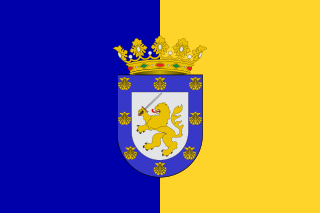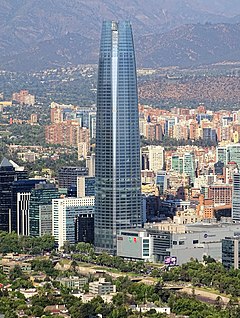
Santiago, also known as Santiago de Chile, is the capital and largest city of Chile and one of the largest cities in the Americas. It is located in the country's central valley and is the center of the Santiago Metropolitan Region, which has a population of 7 million, representing 40% of Chile's total population. Most of the city is situated between 500–650 m (1,640–2,133 ft) above sea level.

Sanhattan, a portmanteau of Santiago and Manhattan, is the popular ironic sobriquet given to Santiago's upscale financial district in Chile's capital. It is located to the northeast of the metropolis, in the western end of the Las Condes commune, nestled between the Mapocho River and Américo Vespucio avenue, encompassing the El Bosque Norte and El Golf barrios. A more narrow definition places it between the intersection of Andrés Bello and Vitacura avenues down to Nueva Los Leones avenue. The central street in Sanhattan is Avenida Apoquindo.

The Torre Latinoamericana is a skyscraper in downtown Mexico City, situated in the historic city center. Its central location, height, and history make it one of the city's most important landmarks. It is widely recognized internationally as an engineering and architectural landmark since it was the world's first major skyscraper successfully built on highly active seismic zone. The skyscraper notably withstood the 8.1 magnitude 1985 Mexico City earthquake without damage, whereas several other structures in the downtown area were damaged.

The Parque Central Complex is a housing, commercial and cultural development, implemented by Centro Simón Bolívar and located in the area known as El Conde in the center of the city of Caracas, Venezuela adjacent to Paseo Vargas.

The Costanera Center is a commercial and business complex located in the commune of Providencia, Santiago, Chile. Owned by Cencosud, the complex consists of four skyscrapers, including the Gran Torre Santiago, two high-end hotels, an office building, and a six-floor shopping mall.

The Torre de Cristal is a skyscraper in the Cuatro Torres Business Area (CTBA) in Madrid, Spain, completed in 2008. With a final height of 249 m (817 ft), it surpassed Torre Emperador as the tallest building in Spain, and is the fourth-tallest in the European Union.
Madrid, the capital of Spain, is divided into 21 districts, which are further subdivided into 131 administrative wards. Additional neighborhoods exist outside the boundaries of administrative borders. Each district is governed by a body named Junta Municipal de Distrito. Residents of Madrid are typically called Madrileños.

The Iberdrola Tower is an office skyscraper in Bilbao, Spain. Its construction started on 19 March 2009 and was officially inaugurated by King Juan Carlos I on 21 February 2012. The tower has a height of 165 metres (541 feet) tall and has 40 floors. The first eight floors of the tower were to hold a hotel by the Spanish hotel chain ABBA, but the project was eventually cancelled. The hotel will be replaced by an auditorium with the capacity of 200 people. The remaining floors have an office usage. The tower, built as Iberdrola's headquarters, is the tallest building in the Basque Country and the city of Bilbao, and the eighth tallest building in Spain.

Titanium La Portada is an office building in Santiago, Chile. Located in the capital's high-end financial district of El Golf, it is the second tallest skyscraper in the country. Construction began in January 2007, and was completed in January 2010. It was surpassed in height by the then unfinished Gran Torre Santiago in November 2010. It was officially inaugurated on May 3, 2010. The architects are Abraham Senerman and Andrés Weil.

The Landmark is a postmodern supertall skyscraper in Abu Dhabi, United Arab Emirates. The mixed-use project stands 324 metres (1,063 ft) tall with 72 floors above ground and five basement levels. Construction on the skyscraper started in late 2006 and the building was completed in 2013. It is the second tallest building in Abu Dhabi behind the Burj Mohammed bin Rashid in the Central Market Project World Trade Center complex.

The Sevilla Tower, known until 2015 as the Pelli Tower, is an office skyscraper in Seville, Spain. Its construction started in March 2008 and was completed in 2015. The tower is 180.5 metres (592 ft) tall and has 40 floors. It is an office building, with the entrance to the tower located off Odiel street. The tower is the tallest building in Andalusia and in the city of Seville, and the seventh tallest in Spain. It provides a panoramic view on all Seville.

The UniCredit Tower is a skyscraper in Milan, Italy. At 231 metres (758 ft), it is the tallest building in Italy.

Salesforce Tower, formerly known as Transbay Tower, is a 61-story skyscraper at 415 Mission Street, between First and Fremont Street, in the South of Market district of downtown San Francisco. Its main tenant is Salesforce, a cloud-based software company. The building is 1,070 feet (326 m) tall, with a top roof height of 970 feet (296 m). Designed by César Pelli and developed by Hines Interests Limited Partnership and Boston Properties, it was the last building designed by Pelli to be completed in his lifetime. As of 2018, Salesforce Tower is the tallest building in San Francisco and the second-tallest building both in California and west of the Mississippi River after the 1,100 feet (335 m) Wilshire Grand Center in Los Angeles.

Bicsa Financial Center, first named Ice Tower, then Star Bay Tower, is a 66-story skyscraper in Avenida Balboa, Panama City. Standing 267 m (876 ft) tall, it is the third tallest building in Panama City and fourth in Latin America.

Azabudai Hills, formerly tentatively known as the Toranomon-Azabudai District or Toranomon-Azabudai Project, is a complex of three skyscrapers under construction in Tokyo, Japan. Upon completion, the complex will contain the tallest building in Tokyo and Japan.
























